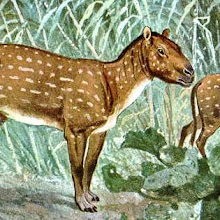This blog is named after something rather obscure, but I like it. The Pterygotus is a eurypterid, which comes from the Greek words eury, meaning "wide," and pteron, meaning "wing." The Eurypterids are also known as sea scorpions and are predators. "Pterygotus" is actually a genus currently encompassing three other euryptids, but usually refers to Pterygotus Anglicus. It is the second largest eurypterid, but Jaekelopterus is larger. It can be up to 7 feet long. It looks like a lobster with large compound eyes and also had some smaller eyes. It has pincers, 4 small legs on each side, and another pair of legs that act like flippers. I have chosen to place a picture of it at the top of the blog. Luckily for people who are afraid of 7 foot arthropods, it , as well as all other eurypterids, is extinct and lived during the Silurian Era, while other eurypterids ranged from the Ordovician to the Permain period. They used to live in shallow waters, like crustaceans. Some Eurypterids lived in salt water; these tended to be the earlier ones, but eventually went to brackish and fresh water. Brackish water is water that is in between fresh and salt water. This is estimated to have happened during the Pennsylvanian era, so I'm guessing that Pterygotus lived in salt water. For the convenience of people who do not have knowledge of the different time periods which ancient creatures are said to have lived in, I will list these and say what time they occurred. The first period is the Cambrian, 542 - 488.3 mya, which is when an "explosion" of sea life happened, I say the sea because sea life was mostly the only life that existed in this time. Next came Ordovician, 488.3 - 443.7 mya, and then Silurian, 443.7 - 416 mya, sea life was still the most important at this time, but many of the Cambrian species went extinct during this time. The Devonian Era, 416 - 359.2 mya, was when life started forming on the land. The Carboniferous Era, 359.2 - 299 mya, which was also divided into the Mississippian Era and the Pennsylvanian Era, came next. Then in the Permian Period, 299 - 251 mya, brought about the extinction of more life. This was the Paleozoic Era. The Mesozoic had Dinosaurs in it, and then comes the Cenozoic Era. I will discuss some things in the Cenozoic Era, but I will not divide this further. In case you are wondering, this blog will not be entirely about prehistoric creatures, but it will be a topic for a while.

No comments:
Post a Comment